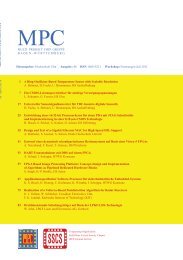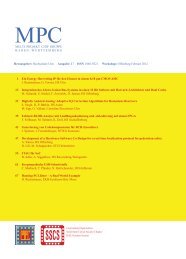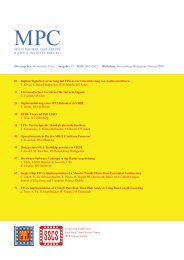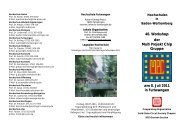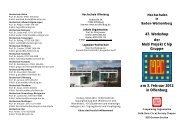Workshopband als PDF - Mpc.belwue.de
Workshopband als PDF - Mpc.belwue.de
Workshopband als PDF - Mpc.belwue.de
Erfolgreiche ePaper selbst erstellen
Machen Sie aus Ihren PDF Publikationen ein blätterbares Flipbook mit unserer einzigartigen Google optimierten e-Paper Software.
Figure 8: Oscilloscope measurements for the low load scenario.<br />
Figure 9: Software application readings for the low load scenario<br />
test.<br />
service, everything else was the same. Further three<br />
sub scenarios for different load conditions were tested<br />
which inclu<strong>de</strong>d the following:<br />
• Run only the IOIO service.<br />
• Run the service plus the music player application<br />
continuously running in background as a service.<br />
• Use the service, the music player playing songs<br />
plus playing a game at the same time<br />
A. Tests without sleep<br />
VIII. RESULTS<br />
On average a <strong>de</strong>lay of 12 ms was experienced for the<br />
two signal cycles. From the measurements it was seen<br />
that adding the load didn't really affect the average<br />
duration a lot (at least in milliseconds) but the variance<br />
did increase when increasing the number of applications<br />
running. Using a web server during the<br />
IOIO operation increased the mean duration as well,<br />
which was obvious due to processor scheduling. But<br />
apart from only those specific times the oscilloscope<br />
readings were the same. This explains Android scheduling<br />
as well. The foreground activities have most<br />
(~90 %) of the CPU time whereas background activities<br />
share only the remaining resources (~10 %) [25].<br />
Fig. 8 shows the oscilloscope image of one of the tests<br />
being carried out for the low load scenario.<br />
72<br />
Figure 10: Oscilloscope measurements for the high load scenario<br />
and 10 ms sleep time.<br />
Table 1. Repeated readings for the low load test scenario.<br />
Application with no sleep (low load)<br />
test mean durati- variance oscilloscope<br />
# on (ms) (ms) reading (ms)<br />
1 12.09 0.28 12<br />
2 12.21 0.49 12<br />
3 12.23 0.54 12<br />
Fig. 9 shows the software results of the timing test<br />
for the same scenario presented above. Table 1 shows<br />
the timing measurements for three repeated tests for<br />
the same scenario, which are consistent enough to<br />
<strong>de</strong>duce results. Readings were noted for the other test<br />
scenarios as well, but are omitted here due to limited<br />
space.<br />
B. Tests with sleep<br />
HEADLESS ANDROID SYSTEMS FOR<br />
INDUSTRIAL AUTOMATION AND CONTROL<br />
For this set of measurements a huge variation between<br />
the oscilloscope readings was observed. Also<br />
when compared to the readings of the software application<br />
the readings don’t match as for the test measurements<br />
in the “no sleep scenarios”. However, the<br />
mean values are consistent between different tests.<br />
This indicates that the oscilloscope reading <strong>de</strong>pends a<br />
lot on the point in time when the oscilloscope was<br />
stopped to take a measurement. Whereas the difference<br />
between the mean value in the software application<br />
and the measured oscilloscope values presumably<br />
are caused by the increased variance. The mean values<br />
didn't change a lot in the computed results but the<br />
variance increased a lot.<br />
The results <strong>als</strong>o <strong>de</strong>pict that the <strong>de</strong>lays ad<strong>de</strong>d by adding<br />
more load to the processor are small enough to<br />
remain in the given timing requirements. Adding the<br />
sleep functionality increases the timing of the whole<br />
setup by almost the same amount as the sleep function<br />
puts the thread on a hold.



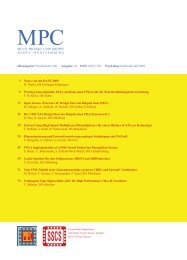
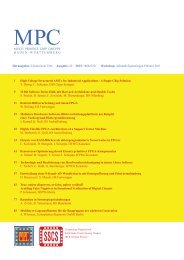
![[Geben Sie hier die Überschrift ein] - MPC](https://img.yumpu.com/8654082/1/188x260/geben-sie-hier-die-uberschrift-ein-mpc.jpg?quality=85)
